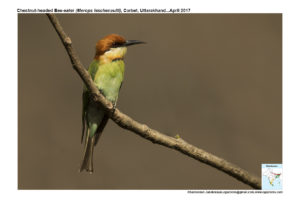
Chestnut-headed Bee-eater Merops leschenaulti
Etymology:
- Merops : Greek word for Bee-eater
- Leschenaulti : Named after French Ornithologist Jean Baptiste Louis Claude Théodore Leschenault de la Tour (1773–1826)
Vernacular Names : Hindi: Lalsir patringa, Guj: Pithakanth pathrango, Ta: Kattalan kuruvi, Panchankam, Mal: Veli tatha, Kendale patranga, Sinh: Kurumini kurulla, Mar: Badami Dokyacha Raghu
Distribution in India: Summer Visitor in Lower Himalayas, Resident in North East of India, Andamans and Western Ghats . Also Passage migrant in South east coast.
Description: Size of 20–22·5 cm; Wt. of 23–33 g. It is a distinctive, smallish bee-eater with long wings but without long tail-streamers. The nominate race has bay-brown crown and mantle, green wings with broad black band over trailing edge, azure rump; black mask, yellow chin, cheeks and throat, rufous lower throat, thin black gorget. The upper breast is yellow, lower breast is green, belly blue-green, bluer towards undertail-coverts; iris red. Sexes alike. Juvenile has forehead, crown and mantle are green. Race andamanensis is larger with mask reduced and rufous, like sides of breast; race quinticolor has mask mostly chestnut, with lower throat yellow, tail blue and has shorter wing than in nominate.
Habitat: It is found in sub-tropical open woodland, often near water. It is most common in highland areas .It is found from sea-level to 1600.
Food Habits: They predominantly eat insects, especially bees, wasps and ants, which are caught in the air by sorties from an open perch. Before swallowing prey, a bee-eater removes stings and breaks the exoskeleton of the prey by repeatedly thrashing it on the perch
Breeding Habits: The breeding season is from March to June. They are gregarious, nesting colonially in sandy banks or open flat areas, making a tunnel in a sandy bank. The breeding pairs are often joined by helpers. The nest tunnel that they construct can run as much as 5 feet long and the 5-8 eggs are laid on the bare ground in the cavity at the end of the tunnel. The eggs are very spherical and glossy white. Clutch size depends on rainfall and insect food density. Both sexes incubate. The eggs hatch asynchronously with an incubation period of about 14 days and the chicks fledge in 3 to 4 weeks.